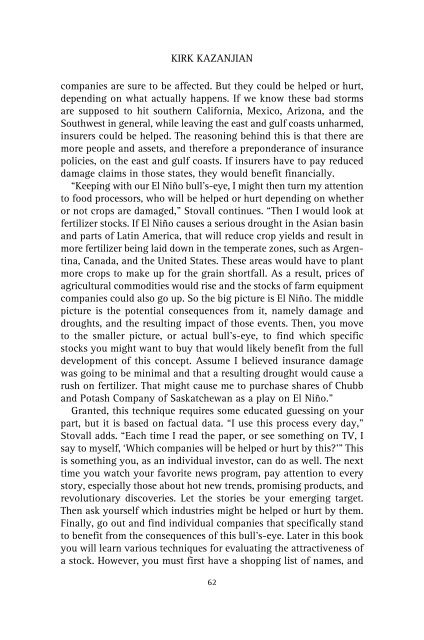You also want an ePaper? Increase the reach of your titles
YUMPU automatically turns print PDFs into web optimized ePapers that Google loves.
KIRK KAZANJIAN<br />
<strong>com</strong>panies are sure to be affected. But they could be helped or hurt,<br />
depending on what actually happens. If we know these bad storms<br />
are supposed to hit southern California, Mexico, Arizona, and the<br />
Southwest in general, while leaving the east and gulf coasts unharmed,<br />
insurers could be helped. The reasoning behind this is that there are<br />
more people and assets, and therefore a preponderance of insurance<br />
policies, on the east and gulf coasts. If insurers have to pay reduced<br />
damage claims in those states, they would benefit financially.<br />
“Keeping with our El Niño bull’s-eye, I might then turn my attention<br />
to food processors, who will be helped or hurt depending on whether<br />
or not crops are damaged,” Stovall continues. “Then I would look at<br />
fertilizer stocks. If El Niño causes a serious drought in the Asian basin<br />
and parts of Latin America, that will reduce crop yields and result in<br />
more fertilizer being laid down in the temperate zones, such as Argentina,<br />
Canada, and the United States. These areas would have to plant<br />
more crops to make up for the grain shortfall. As a result, prices of<br />
agricultural <strong>com</strong>modities would rise and the stocks of farm equipment<br />
<strong>com</strong>panies could also go up. So the big picture is El Niño. The middle<br />
picture is the potential consequences from it, namely damage and<br />
droughts, and the resulting impact of those events. Then, you move<br />
to the smaller picture, or actual bull’s-eye, to find which specific<br />
stocks you might want to buy that would likely benefit from the full<br />
development of this concept. Assume I believed insurance damage<br />
was going to be minimal and that a resulting drought would cause a<br />
rush on fertilizer. That might cause me to purchase shares of Chubb<br />
and Potash Company of Saskatchewan as a play on El Niño.”<br />
Granted, this technique requires some educated guessing on your<br />
part, but it is based on factual data. “I use this process every day,”<br />
Stovall adds. “Each time I read the paper, or see something on TV, I<br />
say to myself, ‘Which <strong>com</strong>panies will be helped or hurt by this?’” This<br />
is something you, as an individual investor, can do as well. The next<br />
time you watch your favorite news program, pay attention to every<br />
story, especially those about hot new trends, promising products, and<br />
revolutionary discoveries. Let the stories be your emerging target.<br />
Then ask yourself which industries might be helped or hurt by them.<br />
Finally, go out and find individual <strong>com</strong>panies that specifically stand<br />
to benefit from the consequences of this bull’s-eye. Later in this book<br />
you will learn various techniques for evaluating the attractiveness of<br />
a stock. However, you must first have a shopping list of names, and<br />
62










